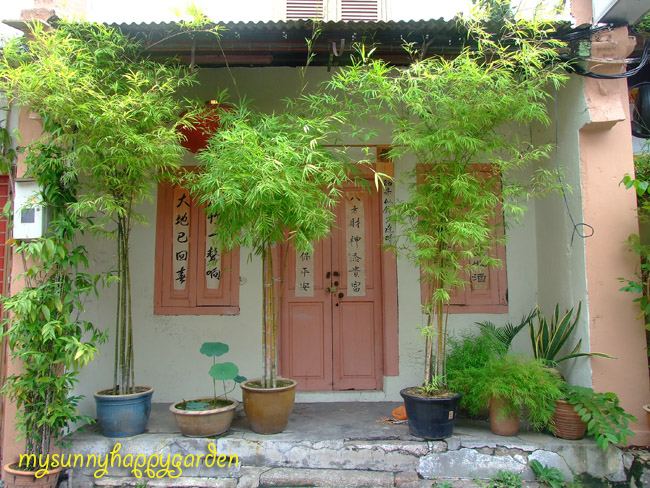Last weekend I saw some shops in the old part of Melaka town displaying pots of bamboo outside their shops. The bamboo plants look so refreshing green. They brighten up the whole place, don't you think so? Together with the Chinese caligraphy and paper cutting art on the wall, these bamboo trees add a touch of Oriental flavour to the decor of these old shop houses.


Going online to do some internet search, I found some key points that one needs to take note when growing bamboo. If you are keen to grow bamboo trees, do take note!
Basic Information About Bamboo
=========================
Bamboo is a grass (subfamily Bambusoideae within the family Gramineae). It
can range in size from inches to over 100' and can grow a foot or more a day.
Bamboo is one of the most useful plants grown in the world. It's used as food,
building material, animal fodder, ornamentation and screening. They are
recognizable by their nodes, the joints between the hollow segments of the
branch or culm.
The easiest way to classify bamboo is to divide it into runners and
clumpers.Clumpers or sympodial bamboos will expand, just like any
other perennial plant. However clumping bamboos have a limited root structure
and cannot creep more than a few inches per year. They will expand each year and
won't grow to mature height unless they are allowed to reach their desired
circumference. Most of the clumping bamboos are tropical plants, but some of the
Fargensia genus exhibit enough cold hardiness to survive done to Zone 4.Runners are what make gardeners run for cover. Running or
monopodial bamboos spread by underground rhizomes and can cover great distances.
Since they are all connected as one plant, it can become impossible to kill off.
However the rhizomes grow at a depth of only 2 - 18 inches and can be contained
with 2 - 2 1/2' plastic edging buried around the circumference of the plant. Any
cracks or seams in the edging will allow rhizomes to get through. Most of the
temperate bamboos are runners. Temperate bamboos are used to a period of cold
weather dormancy and may suffer leaf drop if grown indoors.
Growing Bamboo: Some Key Points
===========================
- Most bamboos prefer full sun and a soil pH of around 6.0 - 6.2.
- Newly planted bamboo requires liberal watering. However, watering newly planted bamboos every day, or for longer than a few minutes can cause excess leaf drop. Well-established bamboos are rather tolerant of flooding, but newly planted bamboos can suffer from too much as well as too little water. (Ha ha this is certainly a difficult requirement for new bamboo planter to manage!)
- Lack of water is the biggest problem with growing bamboo.
- Bamboos require water to send out new culms.
- Standing water inhibits the growth of bamboo.
- Bamboo doesn't like competition from weeds.
- Taller bamboo should be staked, to prevent uprooting.
- Bamboos are evergreen and will lose and replace leaves as they grow.
- Since bamboos are grasses and are grown for their foliage. Feed them with a high nitrogen fertilizer, for instance the NPK 21:5:6 formula.
- Mulching will help control moisture and will protect cold hardy varieties in winter.
- Bamboo like other plants requires some pruning to maintain its
attractiveness. Bamboo culms live only to about 15 years. Once each year you should remove older unattractive culms and cut off any dead or unattractive branches. You can prune bamboo without fear of damaging it. Just trim so it looks attractive. Make cuts just above a node, so as not to leave a stub that will die back and look unsightly.


4 comments:
You are right JC! Those bamboos are really so apt for that place. So, 'Chinese' looking he he... I love the green that the bamboo foliage bring to the place. Yes yes... so refreshing!
Thanks for such a good information!
I love bamboo but I am afraid of growing it in my garden because of it taking over. Now with the info you have provided I may just reconsider.
Hi,
what species of bamboo did you use in the first fhoto. I'm from Brazil, and I', searching for this type
Thanks
Post a Comment